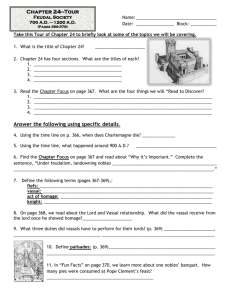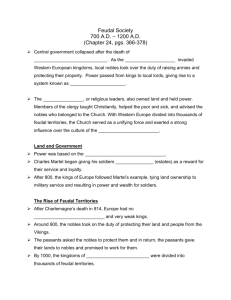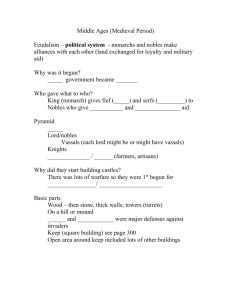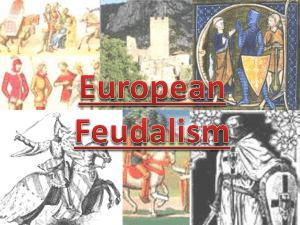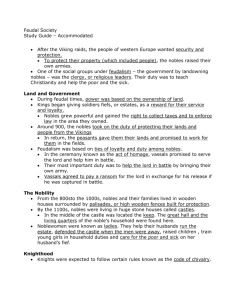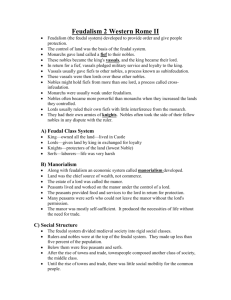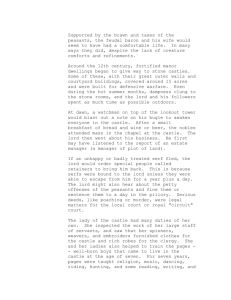Chapter 24: Feudal Society, 700 A.D.
advertisement
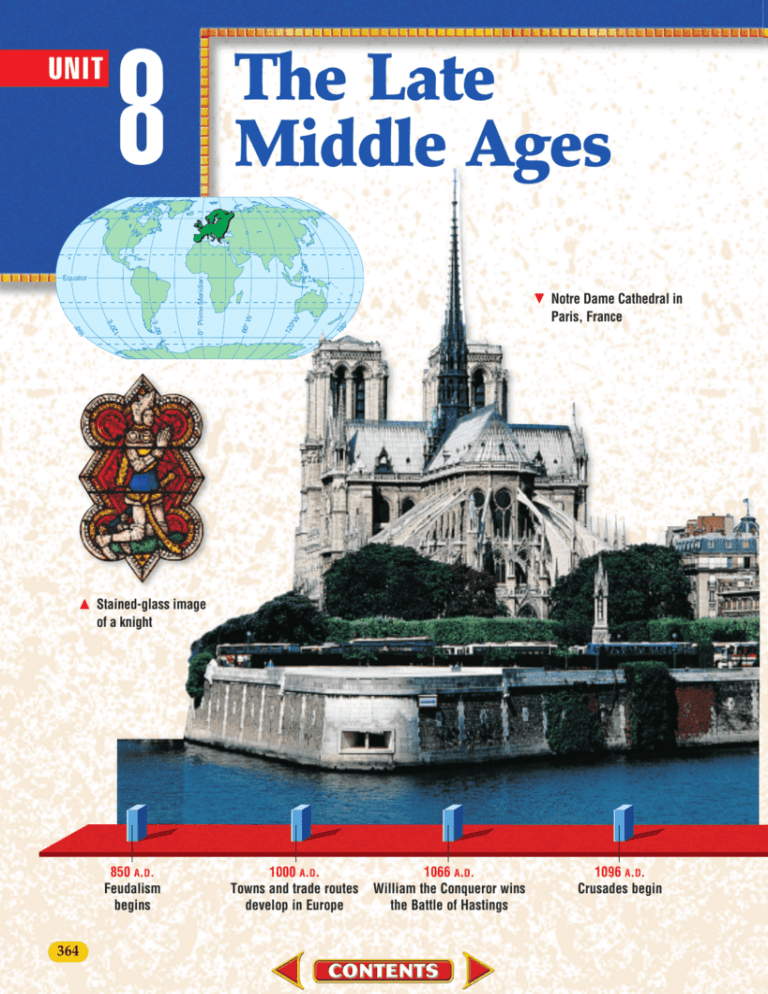
8 12 0° W 60° W E 60° 0°E 12 0° 18 Equator The Late Middle Ages 0° Prime Meridian UNIT Notre Dame Cathedral in Paris, France 0° 18 Stained-glass image of a knight 850 A.D. Feudalism begins 364 1000 A.D. Towns and trade routes develop in Europe 1066 A.D. William the Conqueror wins the Battle of Hastings 1096 A.D. Crusades begin TM Organizing Information Study Foldable Make the following foldable to help you organize information about the changes that occurred during the late Middle Ages. Step 1 Fold two sheets of paper in half from top to bottom. Step 2 Place glue or tape along both 1⁄2 inch tabs. Reading and Writing As you read Fold both sheets to leave 1 2 inch tab on top. Step 3 Fit both sheets of paper together to make a cube as shown. Step 4 Turn the cube and label the foldable as shown. Roman Catholic Church the unit, list the developments that occurred in western Europe during the late Middle Ages. Write the developments under the correct foldable category. Feudalism e ad Strong Tr nd s Natio an w Governmnal ents To PRIMARY SOURCES Library See pages 688–689 for other primary source readings to accompany Unit 8. Read “Plan for a Crusade” from the World History Primary Source Document Library CD-ROM. es Journal Not late like during the What was life out it ote details ab N s? e g A le d Mid as you read. 1152 A.D. Frederick I becomes Holy Roman Emperor 1215 A.D. Magna Carta is signed 1337 A.D. Hundred Years’ War begins 365 CHAPTER 24 Feudal Society 700 A.D. –1200 A.D. A drinking vessel used by peasants Peasant woman carrying sack of wheat 814 A.D. Charlemagne dies 366 900 A.D. Nobles defend themselves against the Vikings UNIT 8 THE LATE MIDDLE AGES 1000 A.D. Western Europe is divided into feudal territories 1100s A.D. Most nobles live in stone castles Chapter Focus Chapter Overview Visit the Human Heritage Web site at humanheritage.glencoe.com and click on Chapter 24— Chapter Overviews to preview this chapter. Read to Discover • • • • Why feudalism developed in western Europe. What roles were played by lords and vassals. What the duties of a knight were. What life was like on a manor. Terms to Learn feudalism clergy fiefs vassal act of homage knight castles keep ladies code of chivalry page squire dubbing tournaments joust manors seneschal bailiff freemen Why It’s Important Central government collapsed after the death of King Charlemagne. As the Vikings invaded western European kingdoms, local nobles took over the duty of raising armies and protecting their property. Power passed from kings to local lords, giving rise to a system known as feudalism (fyoo’ dul ih zum). Under feudalism, landowning nobles governed and protected the people in exchange for services, such as fighting in a noble’s army or farming the land. The clergy, or religious leaders, also owned land and held power. Members of the clergy taught Christianity, helped the poor and sick, and advised the nobles who belonged to the Church. With western Europe divided into thousands of feudal territories, the Church served as a unifying force and exerted a strong influence over the culture of the Middle Ages. Reading Check What was feudalism? Reading Check Who were the clergy? SECTION 1 Land and Government During feudal times, power was based on the ownership of land. Before feudalism, kings owned all the land within their territories. Then Charles Martel, the Frankish leader, began giving his soldiers fiefs (fēfs), or estates, as a reward for their service and loyalty. From their fiefs, the soldiers got the income they needed to buy horses and battle equipment. After 800, the kings of Europe followed Martel’s example. From that time on, land ownership was tied to military service. With land ownership went power and wealth, giving soldiers a base from which to rule Europe. Reading Check Why did soldiers receive fiefs during the Middle Ages? CHAPTER 24 FEUDAL SOCIETY 367 The Rise of Feudal Territories After Charlemagne’s death in 814, Europe had no central government. The kings who followed Charlemagne were so weak they could not even rule their own kingdoms well. They ignored their responsibilities and spent most of their time traveling from one royal estate to another. Before long, they began to depend on the nobles for food, horses, and soldiers. Some nobles grew more powerful than the king and became independent rulers. They gained the right to collect taxes and to enforce the law in their areas. Many nobles raised armies and coined their own money. Around 900, the nobles took on the duty of protecting their lands and people from the Vikings. They built fortresses on hilltops and fenced their lands. The peasants asked these powerful nobles to protect them. In return, the peasants gave their lands to nobles and promised to work for them in the fields. However, most peasants ended up giving the nobles not only their land but also their freedom. By 1000, the kingdoms of western Europe were divided into thousands of feudal territories. Each was about the size of an ancient Greek city-state. Unlike the polis, however, a feudal territory had no central city. The noble who owned the land also had the political power. He made the laws for his fief, and the people obeyed them. Peasants, unlike Greek citizens, had no say in the government. Although the peasants and townspeople made up the largest group, they had fewer rights than the clergy and nobles. Almost everyone believed that God wanted it that way. As a result, few people tried to improve society or change their own way of life. Most people remained in the group into which they were born. Reading Check What were the duties of a vassal? What took place during an act of homage? 368 Lord and Vassal Feudalism was based on ties of loyalty and duty among nobles. Nobles were both lords and vassals. A vassal (vas’ uhl) was a noble who served a lord of higher rank and gave him loyalty. In return, the lord protected the vassal. All nobles were ultimately vassals of the king, who might even be the vassal of another king. The tie between lord and vassal was made official in a special ceremony known as the act of homage (om’ ij). The vassal, his head bare to show respect, knelt on one knee and placed his hands between those of the lord. He promised to serve the lord and to help him in battle. The lord accepted the promise, helped the vassal to his feet, and kissed him. In return for the promise of loyalty and service, the lord gave his vassal a fief. Since there were few written agreements in the Middle Ages, the lord gave his vassal a glove, a stick, or a stone. This was to show that the lord’s word could be trusted. He also gave the vassal the right to govern the people who lived on the UNIT 8 THE LATE MIDDLE AGES fief. The lord promised to protect his vassal from enemy attacks. If the lord failed in this, the vassal no longer owed him loyalty. Vassals had certain duties to perform. Their most important duty was to help the lord in battle. Vassals had to bring their own knights with them. They themselves were expected to take part in military service 40 to 60 days a year. Vassals had to make payments to their lord. When a lord’s daughter married, or his son became a knight, or a warrior on horseback, his vassals had to give the lord money. If a lord were captured in battle, his vassals either became prisoners in his place or paid his ransom. This is a sum of money given in exchange for a person’s release. Another duty of vassals was to attend the lord’s court. Vassals were also expected to provide food and entertainment when their lord visited them. If a vassal failed in his duties to his lord, the lord had the right to take away the vassal’s fief. When a vassal died, his fief usually passed on to his oldest son. The son then performed the act of homage. Reading Check What was a knight? Graphic Organizer Activity 1. Define: feudalism, clergy, fiefs, vassal, act of homage, knight. 2. How did land ownership become tied to military service? 3. How did nobles become so powerful? 4. What were some duties of a vassal? 6. Draw this diagram, and use it to show some of the causes of feudalism. es Caus Section 1 Assessment Feudalism Critical Thinking 5. Demonstrating Reasoned Judgment What were the advantages of being a vassal? What were the disadvantages? SECTION 2 The Nobility Life was not always easy or pleasant for nobles during feudal times. They did, however, enjoy more benefits than the common people. From the 800s to the 1000s, nobles and their families lived in wooden houses surrounded by palisades (pal uh sāds’), or high wooden fences built for protection. In case of attack, people from nearby villages sought shelter inside the palisade. The house consisted of one room with a high ceiling and a straw-covered floor. All activity took place in that one room. There, nobles met with vassals, carried out the laws, and said their prayers. The nobles, their families, servants, and warriors CHAPTER 24 FEUDAL SOCIETY 369 Too Much! Guests at a noble’s banquet consumed huge amounts of food. In the 1340s, Pope Clement VI gave a feast that included 13,000 birds, 1,000 sheep, 50,000 fruit pies, and 200 casks of wine. At the 1403 wedding of Henry IV of England and Joan of Navarre, the royal couple tasted about 100 separate dishes. NOBLE’S FEAST Nobles celebrated special occasions with elaborate feasts. Such meals often included many courses of meats, fruits, and vegetables. In this painting a noble sits down to dinner while his many servants bring out more food. Where were meals for nobles held? also ate and slept in that room. At mealtime, wooden tables were set up and piled high with meat, fish, vegetables, fruits, and honey. People ate with their fingers and threw scraps of food on the floor for the dogs. The straw got so dirty with mud, bones, and food that every few months it had to be swept outdoors and burned. The fires that cooked the meals were also used to heat the house. Actually, the fires did little to keep out the cold. Smoke from them often stung the eyes and darkened the walls and ceiling. The Castle Reading Check What did castles look like? 370 By the 1100s, nobles were living in stone houses called castles. Because they were designed as fortresses, the castles made nobles secure and independent. Castles had thick stone walls, one within another. Each corner had its own lookout tower with archers in it. Some castles were further protected by a moat with a soft and muddy bottom that stopped attackers from using ladders to climb over the outer walls. To cross the moat, a UNIT 8 THE LATE MIDDLE AGES person had to use the castle’s drawbridge, which could be raised to prevent entry. The drawbridge led to the portcullis (pōrt kul’ is), an iron gate that often served as the entrance to the castle. Within the castle walls was a large open area. In the middle of this area was a keep, or tall tower with thick walls. It contained a great hall, many rooms, and a dungeon. The people of the household lived in the keep, which could be defended even if the rest of the castle fell to attackers. Shops, kitchens, stables, and rooms for troops and guests were also built inside the castle walls. Many people, including the noble’s servants and officials, lived in the castle. Since the noble was away fighting most of the time, the servants and officials were responsible for the castle’s care and defense. Most castles had enough space to store a large supply of food and drink. As a result, people inside a castle could hold out against attackers for as long as six months. Reading Check Why did the people of a household live inside the keep? Student Web Activity Visit the Human Heritage Web site at humanheritage.glencoe.com and click on Chapter 24— Student Web Activities to find out more about castles. CASTLE A castle was both a noble’s home and a military fortress. During enemy attack, people from the surrounding area sought protection within the castle walls. Here, the moat and entrance of an English castle are shown. Who was responsible for a castle’s care and defense? CHAPTER 24 FEUDAL SOCIETY 371 Reading Check What was the main purpose of marriage for most ladies in the Middle Ages? Castle Life When nobles were at home, they looked after their estates, went hunting and fishing, and held court. During long winter evenings, they often played chess with family members. Wandering minstrels sometimes came to entertain the nobles and their guests by singing songs and playing stringed instruments. Noblewomen were called ladies. Once they married, their husbands had complete authority over them. Most marriages were planned to unite important families, and a woman had little say about who was chosen for her. The bride’s family gave the groom a dowry. Most nobles looked for wives with large dowries. Women were often married by the time they were 12 years old. Those who were not married by the time they were 21 could expect to stay single for the rest of their lives. Wives helped their husbands run their estates. When the men were away, the women had to defend the castle. The main duties of a wife, however, were to have and raise children and to Chess After the game arrived in Europe from India about 1000 A.D., noble lords and ladies played chess (above) to pass the hours. In recent years, chess masters such as Russian expert Gary Kasparov (right) have matched their wits with chess-playing computers. What other activities were popular in the Middle Ages? 372 UNIT 8 THE LATE MIDDLE AGES take care of the household. She was also expected to train young girls from other castles in household duties and to supervise the making of cloth and fine embroidery. Another duty was to use her knowledge of plants and herbs to care for the poor and sick on her husband’s fief. Section 2 Assessment 1. Define: castles, keep, ladies. 2. What activities took place in the noble’s house? 3. How did the design of a castle protect people? 4. What were the duties of a feudal noblewoman? castle life would you have liked? What parts would you have disliked? Graphic Organizer Activity 6. Draw this diagram, and use it to compare the living conditions of nobles before and after the rise of castles. Before Critical Thinking Rise of Castles After 5. Drawing Conclusions What parts of SECTION 3 Knighthood Almost all nobles were knights. However, knighthood had to be earned. Knights were expected to follow certain rules known as the code of chivalry (kōd of shiv’ uhl r ē). These rules stated that a knight was to obey his lord, show bravery, respect women of noble birth, honor the Church, and help people. A knight was also expected to be honest and to fight fairly against his enemies. The code of chivalry became the guide to behavior from which the western idea of good manners developed. Reading Check What was the code of chivalry? Training A noble began training to be a knight when he was seven years old. He was sent away from his family to the castle of another lord. There, he learned to be a page, or a person who helped the knights of the castle care for their destriers (dā trē’ uhrs), or war-horses. Pages also polished the knights’ armor, some of which weighed up to 80 pounds, or 36 kilograms. A page learned good manners and ran errands for the ladies. He was taught to ride and fight. By the age of 14, he could handle a lance and sword while on horseback. When he was 15 years old, a page became a squire. Each squire was put under the care and training of one knight. The squire’s duty was to go into battle with his knight. He was expected to rescue the knight if he was wounded or fell off his horse. If the squire proved to be a good fighter, he was rewarded by being made a knight. This was done in a special ceremony Reading Check What did a page hope to become? Reading Check What were the duties of a squire? CHAPTER 24 FEUDAL SOCIETY 373 Coats of Arms To identify themselves in battle, knights had individual designs, or “coats of arms,” painted on their shields and tunics. In noble families, the coat of arms passed down through the generations. The flags of some modern European nations are based on medieval coats of arms. MEDIEVAL TOURNAMENT In this painting knights on horseback joust during a tournament while other knights fight hand to hand. Why were medieval tournaments costly events? Reading Check What took place during the ceremony known as dubbing? known as dubbing. The squire knelt before his lord with his sword suspended from his neck. He then promised to defend the Church and his lord, and to protect the weak. Then, the lord tapped the squire on his shoulder with the blade of a sword and pronounced him a knight. The knight’s sword was placed in a scabbard, or sword holder, at the knight’s side. This showed that the knight would fight by the side of his lord. Reading Check What was the purpose of medieval tournaments? Tournaments Reading Check What was the event known as the joust? 374 Knights trained for war by fighting each other in tournaments, or special contests that tested strength, skill, and endurance. Tournaments were held in large fields. They were exciting gatherings that brought in lords, ladies, and knights who watched the events from stands. The most popular event was the joust (jowst). Two armored knights on horseback carrying dull lances galloped towards each other from opposite ends of the field. Each tried with all his strength and skill to knock the other to the ground with his lance. The cost of tournaments was high. Men and horses were killed and wounded. Lances, swords, and suits of armor were damaged. The noble who gave the tournament had to feed hundreds of people. In spite of the cost, however, tournaments remained popular. In fact, it was believed that a knight who had not learned to fight in one could not fight well in battle. UNIT 8 THE LATE MIDDLE AGES Section 3 Assessment Graphic Organizer Activity 1. Define: code of chivalry, page, squire, dubbing, tournaments, joust. 2. Why did noble families send their sons to other castles to work as pages? 3. How did knights train for war? 5. Draw this diagram, and use it to show the steps leading to knighthood. Knighthood Step 3 Critical Thinking 4. Making Comparisons How were tournaments similar to the Olympic games in ancient Greece? How were they different? Step 2 Step 1 SECTION 4 The Manor Nobles, knights, and peasants all depended on the land for everything they needed. The land was divided into manors, or farming communities. Manors were found on fiefs and were owned by nobles. Reading Check What were manors? Daily Life Reading Check Who was the seneschal? The noble chose a number of officials to run his manor. They were loyal to the noble and made sure his orders were carried out. One official was the seneschal (sen’ uh shuhl). CHAPTER 24 FEUDAL SOCIETY 375 Reading Check What was the main job of a bailiff? Peasant Life A typical peasant’s cottage had one door that opened into a central room with a pressed dirt floor. Often a number of animals— piglets, ducklings, cats, and hens—shared the space with a married couple and their children. In cold weather, a cow might be brought inside to be near the warmth of the fire. He looked after the noble’s fiefs by visiting each fief regularly. Another official was the bailiff (bā’ lif). He made sure the peasants worked hard in the fields. Every manor had its own court of law. The court settled differences, gave out fines and punishments, and discussed manor business. Poor transportation and frequent fighting isolated manors from one another. The men and women of each manor produced food, clothing, and shelter for themselves and the noble. They raised sheep for wool and cattle for meat and milk. They also grew grain and vegetables, made cloth, built homes, and fashioned tools. The noble of each manor lived in a wooden house or a castle. Nearby stood a small village of cottages in which the peasants lived. Most villages also had a church, a mill, a bread oven, and a wine press. Around the village were forests, meadows, pastures, and fields. The cottages were crowded around an open area called the village green. They were made of wood and earth and had thatched roofs. Most had only one room. At night, family members slept there on piles of straw or on the dirt floor. Three-legged stools and a table were the only furniture. Diseases and fleas from the animals that also slept in the cottage often sickened the people. PEASANTS AT WORK Peasants spent long hours working in the fields of a manor. In these paintings, peasants are shown plowing the fields and doing other tasks on the manor. What other work did the peasants do? 376 UNIT 8 THE LATE MIDDLE AGES Trotula of Salerno C.1097 A.D. Doctor PEASANT CELEBRATION Although peasants’ lives were mostly long hours of hard work, there were times for celebration. Peasants celebrated special occasions with music, dancing, and feasting. Here, the festivities at a peasant wedding are shown. What sports did peasants enjoy? Freemen and Serfs Two groups of peasants worked on a manor. One was the freemen, or peasants who paid the noble for the right to farm land. They worked only on their own strips of land and had rights under the law. They moved wherever and whenever they wished. The noble, however, had the right to throw them off the manor without warning. The other group was the serfs. Serfs and their descendants were a noble’s property. They could not move to another area, own their own property, or marry without the noble’s permission. Serfs, however, could not be driven off the land and did not have to serve in the army. It was not easy for serfs to gain their freedom. One way was to escape to the towns. If a serf was not caught and remained in town for more than a year, he or she was considered free. By the end of the Middle Ages, serfs were allowed to buy their freedom. As in Charlemagne’s time, the serfs worked long hours in the fields and performed many services for the nobles. Serfs spent three days of the week working the lord’s strips of land and the rest of the week caring for their own strips. However, they had to give part of their own crops to the noble. They also paid him for the use of the village’s mill, bread oven, and wine press. In spite of the difficulties, a serf’s life had some bright moments. Sunday was a day of rest from work. At Christmas, the Both noble and peasant women took care of the sick, but Trotula broke with tradition by becoming a trained doctor. She studied and taught at the medical school at Salerno, Italy. Trotula specialized in the health of women and wrote a book called The Diseases of Women. Her book influenced doctors for centuries. Today she is considered one of Europe’s early women of science. Reading Check How did freemen differ from serfs? Serf Work A monk at Canterbury recorded an English serf’s account of his day: “I work very hard. I go out at dawn, driving the oxen to the field, and I yoke them to the plough. However hard the winter, I dare not stay home for fear of my master.” CHAPTER 24 FEUDAL SOCIETY 377 lord paid for a great feast and entertainment. Certain holidays were celebrated with singing and dancing on the village green. When they could, serfs took part in such sports as wrestling, archery, and soccer. By the 1200s, peasants began to learn better farming methods. They used the three-field system of farming and started to use a heavy iron plow. The horse collar was invented, allowing horses instead of slow-moving oxen to plow fields. All of this enabled the peasants to grow more food. Section 4 Assessment Graphic Organizer Activity 1. Define: manors, seneschal, bailiff, freemen. 2. What were some features of a manor village? 3. What rights did freemen have? 4. What did serfs contribute to a manor? 6. Draw this diagram, and use it to show technological improvements in farming in the 1200s. Improved Farming Methods Critical Thinking 5. Making Comparisons What interests did nobles and serfs have in common? Chapter Summary & Study Guide 1. Following Charlemagne’s death, kings began to depend on nobles for food, horses, and soldiers. 2. Some nobles began to collect their own taxes, run their own courts, coin their own money, and raise their own armies. 3. As the power of kings declined, the nobles took on the duty of defending their land and people from Viking attacks. 4. By 1000, the kingdoms of western Europe were divided into thousands of feudal territories. 5. Under feudalism, landowning nobles gave vassals land in exchange for loyalty and military service. 378 UNIT 8 THE LATE MIDDLE AGES 6. Knights followed the code of chivalry and trained for war by fighting in tournaments. 7. Fiefs were owned by nobles and worked by peasants. 8. Peasants included freemen and serfs. While freemen could leave the land if they wished, serfs were considered a noble’s property. 9. By the 1200s, improvements in farming methods helped the peasants to grow more food. Self-Check Quiz Visit the Human Heritage Web site at humanheritage. glencoe.com and click on Chapter 24—Self-Check Quiz to assess your understanding of this chapter. CHAPTER 24 Assessment Graphic Organizer Activity Imagine you are living in the late Middle Ages. Write an interview with a noble and a serf in which they describe their lives. Use the following words in your interview. Citizenship Create a diagram like this one, and use it to show the organization of government under feudalism. Each of these groups should appear on the chart: serfs, landowning nobles, freemen, knights. clergy act of homage keep page tournaments seneschal fiefs knight ladies squire joust bailiff L Po east we r feudalism vassal castles code of chivalry dubbing manors freemen M Po ost we r Using Key Terms Understanding Main Ideas 1. Into what three groups were people divided under feudalism? 2. Who held the political power within a feudal territory? 3. Who usually received a vassal’s fief when the vassal died? 4. What was expected of a knight? 5. Why did people on a manor produce everything they needed? 6. How could serfs obtain their freedom? 7. What changes had taken place in farming by the 1200s? Critical Thinking 1. What advantages would there be to being a vassal rather than a lord? 2. Why do you think women provided the medical care in a fief? 3. What would you have enjoyed about being a knight? What would you have disliked? 4. How do you think a serf’s life would be affected by the improved farming methods of the thirteenth century? Geography in History Environment and Society The people of the manor made good use of their natural resources to support themselves. Predict and describe how you think manor life would have changed if a plant disease had killed all the trees in an area. rnal u o J r You Using may s you il y deta e lives of n a e r a th Comp ted about iddle Ages o n e ay. lat M have n the women tod i n e of wom ning e lives aph explai ces h t h t i n w gr differe a para Write ilarities and ining them la m the si u were exp d on a o y l f o ive as i ne wh . o e m to so an manor e Europ 379
